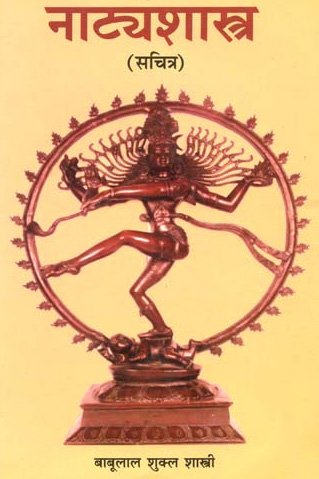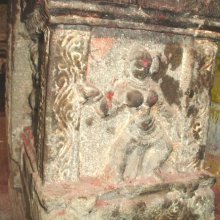Parshvakranta, Pārśvakrānta, Pārśvākrānta, Parshvakramta, Parshva-kranta: 4 definitions
Introduction:
Parshvakranta means something in Hinduism, Sanskrit. If you want to know the exact meaning, history, etymology or English translation of this term then check out the descriptions on this page. Add your comment or reference to a book if you want to contribute to this summary article.
The Sanskrit terms Pārśvakrānta and Pārśvākrānta can be transliterated into English as Parsvakranta or Parshvakranta, using the IAST transliteration scheme (?).
Images (photo gallery)
In Hinduism
Natyashastra (theatrics and dramaturgy)
Source: Wisdom Library: Nāṭya-śāstra1) Pārśvakrānta (पार्श्वक्रान्त).—One of the 108 karaṇas (minor dance movement) mentioned in the Nāṭyaśāstra chapter 4. The instructions for this pārśvakrānta-karaṇa is as follows, “observing the Parśvakrānta Cārī, throwing out hands towards the front, and moving them in a manner befitting the dance.”.
A karaṇa represents a minor dance movements and combines sthāna (standing position), cārī (foot and leg movement) and nṛttahasta (hands in dancing position).
2) Pārśvakrāntā (पार्श्वक्रान्ता) refers to a one of the thirty-two cārīs, according to the Nāṭyaśāstra chapter 11. The Pārśvakrāntā-cārī is classified as a ākāśikī, or “aerial”, of which there are sixteen in total. The term cārī refers to a “dance-step” and refers to the simultaneous movement of the feet (pāda), shanks (jaṅghā) and the hip (ūru). From these cārīs proceed dance as well as movements in general.
Source: archive.org: Natya ShastraPārśvakrāntā (पार्श्वक्रान्ता).—A type of aerial (ākāśikī) dance-step (cārī);—Instructions: one foot Kuñcita and another thrown up and brought near the side.
Source: Shodhganga: Elements of Art and Architecture in the Trtiyakhanda of the Visnudharmottarapurana (natya)Pārśvākrānta (पार्श्वाक्रान्त) refers to one of the 108 kinds of Karaṇa (“coordination of precise movements of legs and hands”), according to the Viṣṇudharmottarapurāṇa, an ancient Sanskrit text which (being encyclopedic in nature) deals with a variety of cultural topics such as arts, architecture, music, grammar and astronomy.—According to the Viṣṇudharmottarapurāṇa, karaṇas are the coordination of precise movements of legs and hands performed in a particular posture. The Nāṭyaśāstra also gives its view point in the same spirit. In the Viṣṇudharmottarapurāṇa, one hundred and eight kinds of karaṇas are accepted, e.g., Pārśvākrānta.

Natyashastra (नाट्यशास्त्र, nāṭyaśāstra) refers to both the ancient Indian tradition (shastra) of performing arts, (natya—theatrics, drama, dance, music), as well as the name of a Sanskrit work dealing with these subjects. It also teaches the rules for composing Dramatic plays (nataka), construction and performance of Theater, and Poetic works (kavya).
Languages of India and abroad
Kannada-English dictionary
Source: Alar: Kannada-English corpusPārśvakrāṃta (ಪಾರ್ಶ್ವಕ್ರಾಂತ):—[noun] (dance.) standing on one foot, and raising the heel of the other as to make it rest only on toes, raising the later foot and stamping the ground with its heel.
Kannada is a Dravidian language (as opposed to the Indo-European language family) mainly spoken in the southwestern region of India.
See also (Relevant definitions)
Partial matches: Parshva, Kranta, Akranta.
Full-text: Parshvadamdapada, Sucividdha, Lalitasancara, Vicitra, Kranta, Alata, Vamaviddha, Dandapada, Vihrita, Atikranta, Carin, Lalita.
Relevant text
Search found 5 books and stories containing Parshvakranta, Pārśvakrānta, Parsva-kranta, Pārśva-krānta, Pārśvākrānta, Parshvakramta, Pārśvakrāntā, Parshva-kranta, Parsvakranta, Pārśvakrāṃta, Parsvakramta, Pārśva-ākrānta, Parshva-akranta, Parsva-akranta; (plurals include: Parshvakrantas, Pārśvakrāntas, krantas, krāntas, Pārśvākrāntas, Parshvakramtas, Pārśvakrāntās, Parsvakrantas, Pārśvakrāṃtas, Parsvakramtas, ākrāntas, akrantas). You can also click to the full overview containing English textual excerpts. Below are direct links for the most relevant articles:
Gati in Theory and Practice (by Dr. Sujatha Mohan)
Gait of birds and animals < [Chapter 2 - Concept and technique of Gati]
Relevance of Gati in Rūpakas < [Chapter 3 - Application of gati in Dṛśya-kāvyas]
Gati pertaining to Characters < [Chapter 3 - Application of gati in Dṛśya-kāvyas]
Natyashastra (English) (by Bharata-muni)
Vishnudharmottara Purana (Art and Architecture) (by Bhagyashree Sarma)
2.5. Karaṇa (movements of legs and hands) < [Chapter 3 - Drama and Dance]
The Religion and Philosophy of Tevaram (Thevaram) (by M. A. Dorai Rangaswamy)
Chapter 4.3 - (c) Sculptures of Shiva and Dance < [Volume 2 - Nampi Arurar and Mythology]
Dance Traditions of South India < [May-June 1935]
